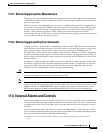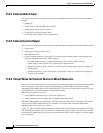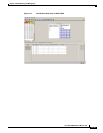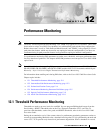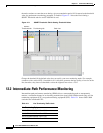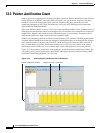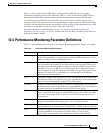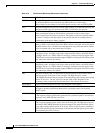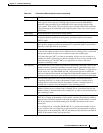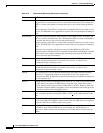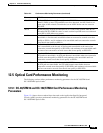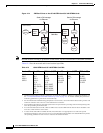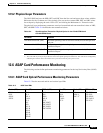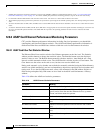
12-5
Cisco ONS 15600 Reference Manual, R7.2
Chapter 12 Performance Monitoring
12.4 Performance-Monitoring Parameter Definitions
PPJC is a count of path-detected (PPJC-Pdet) or path-generated (PPJC-Pgen) positive pointer
justifications depending on the specific PM name. NPJC is a count of path-detected (NPJC-Pdet) or
path-generated (NPJC-Pgen) negative pointer justifications depending on the specific PM name.
A consistent pointer justification count indicates clock synchronization problems between nodes. A
difference between the counts means the node transmitting the original pointer justification has timing
variations with the node detecting and transmitting this count. Positive pointer adjustments occur when
the frame rate of the SPE is too slow in relation to the rate of the STS-1.
For pointer justification count definitions, see the “12.4 Performance-Monitoring Parameter
Definitions” section on page 12-5. In CTC, the PM count fields for PPJC and NPJC appear white and
blank unless IPPM is enabled.
12.4 Performance-Monitoring Parameter Definitions
Table 12-2 gives definitions for each type of performance-monitoring parameter found in this chapter.
Table 12-2 Performance Monitoring Parameters
Parameter Definition
CV-L Line Code Violation (CV-L) indicates the number of coding violations occurring on
the line. This parameter is a count of bipolar violations (BPVs) and excessive zeros
(EXZs) occurring over the accumulation period.
CV-LFE Far-End Line Code Violation (CV-LFE) is a count of bit interleaved parity (BIP)
errors detected by the far-end LTE and reported back to the near-end LTE using the
Line remote error indication (REI-L) in the line overhead. For SONET signals at rates
below OC-48, up to 8 x n BIP errors per STS-N frame can be indicated using the
RDI-L indication. For OC-48 signals, up to 255 BIP errors per STS-N frame can be
indicated. The current CV-L second register is incremented for each BIP error
indicated by the incoming REI-L.
CV-P Near-End STS Path Coding Violations (CV-P) is a count of BIP errors detected at the
STS path layer (that is, using the B3 byte). Up to eight BIP errors can be detected per
frame; each error increments the current CV-P second register.
CV-PFE Far-End STS Path Coding Violations (CV-PFE) is a count of BIP errors detected at
the STS path layer (that is, using the B3 byte). Up to eight BIP errors can be detected
per frame; each error increments the current CV-PFE second register.
CV-S Section Coding Violation (CV-S) is a count of BIP errors detected at the section layer
(that is, using the B1 byte in the incoming SONET signal). Up to eight section BIP
errors can be detected per STS-N frame; each error increments the current CV-S
second register.
ES-L Line Errored Seconds (ES-L) is a count of the seconds containing one or more
anomalies (BPV+EXZ) and/or defects (that is, loss of signal) on the line.
ES-LFE Far-End Line Errored Seconds (ES-LFE) is a count of the seconds when at least one
line-layer BIP error was reported by the far-end LTE or a RDI-L defect was present.
ES-P Near-End STS Path Errored Seconds (ES-P) is a count of the seconds when at least
one STS path BIP error was detected. An AIS-P defect (or a lower-layer,
traffic-related, near-end defect) or an LOP-P defect can also cause an ES-P.



